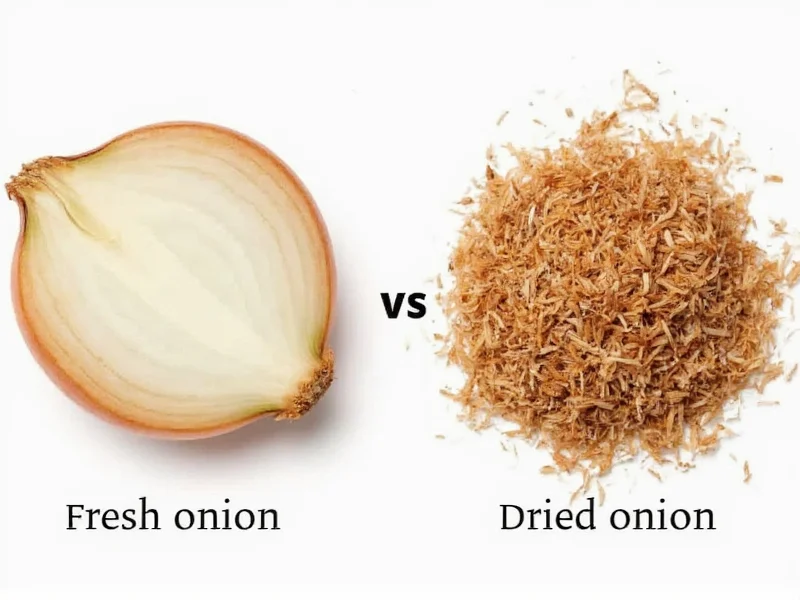Understanding onion conversions is essential for consistent cooking results. When recipes call for specific onion forms, knowing the proper substitution ratio prevents flavor imbalances in your dishes. The key difference lies in moisture content: fresh onions are about 89% water, while dried onions have had nearly all moisture removed, intensifying their flavor profile.
Why Fresh and Dried Onions Aren't a 1:1 Substitute
Many home cooks mistakenly assume they can swap fresh and dried onions in equal amounts, but this leads to disappointing results. Fresh onions contain significant water that affects both texture and flavor concentration. When dehydrated, that water disappears, leaving behind concentrated onion solids. Using equal volumes would make your dish overly onion-forward and potentially alter its texture.
Comprehensive Fresh Onion to Dried Onion Conversion Chart
| Fresh Onion Measurement | Dried Minced Onion Equivalent | Dried Onion Flakes Equivalent |
|---|---|---|
| 1 small fresh onion (1/2 cup chopped) | 2 tablespoons dried minced onion | 3 tablespoons dried onion flakes |
| 1 medium fresh onion (3/4 cup chopped) | 3 tablespoons dried minced onion | 1/4 cup dried onion flakes |
| 1 large fresh onion (1 cup chopped) | 1/4 cup dried minced onion | 1/3 cup dried onion flakes |
| 1 cup fresh chopped onion | 1/3 cup dried minced onion | 1/2 cup dried onion flakes |
| 1 cup fresh onion slices | 3 tablespoons dried minced onion | 1/4 cup dried onion flakes |
Practical Substitution Tips for Best Results
When converting between fresh and dried onions, consider these professional kitchen tips for optimal flavor:
- Rehydrate for texture-sensitive dishes: For recipes where texture matters (like salads or fresh salsas), rehydrate dried onions by soaking 1 tablespoon in 2 tablespoons warm water for 15 minutes before use
- Adjust cooking times: Dried onions don't need the same sautéing time as fresh. Add them later in the cooking process to prevent burning
- Season incrementally: Start with 75% of the recommended dried onion amount, then taste and adjust. You can always add more, but you can't remove excess
- Consider the dish type: Use fresh onions for raw applications and dried for long-cooked dishes where they'll rehydrate naturally
When to Choose Fresh vs. Dried Onions
Understanding when each form shines helps you make better ingredient decisions:
Fresh Onions Work Best For:
- Raw applications (salsas, salads, garnishes)
- Quick-cooking dishes (stir-fries, omelets)
- When you want distinct onion texture
- Dishes requiring subtle onion flavor
Dried Onions Excel In:
- Long-simmering recipes (stews, soups, sauces)
- Dry rubs and spice blends
- Baked goods (breads, biscuits)
- Situations requiring shelf-stable ingredients
Common Substitution Mistakes to Avoid
Even experienced cooks make these errors when converting between fresh and dried onions:
- Using equal volumes: This is the most frequent error, resulting in overly strong onion flavor
- Not accounting for preparation differences: Chopped fresh onion yields more volume than the same weight of dried
- Ignoring recipe moisture balance: Adding dried onions to low-moisture recipes can make them too dry
- Substituting without tasting: Always adjust seasoning after substitution
Special Considerations for Onion Powder
Onion powder requires different conversion ratios than dried minced onions or flakes. As a concentrated form, you'll need less:
- 1 teaspoon onion powder = 1/4 cup fresh chopped onion
- 1/2 teaspoon onion powder = 1 tablespoon dried minced onion
Use onion powder sparingly in delicate dishes, as its fine texture distributes more evenly and its flavor can dominate if overused. It works particularly well in dry rubs, dressings, and sauces where you want uniform flavor distribution without visible onion pieces.











 浙公网安备
33010002000092号
浙公网安备
33010002000092号 浙B2-20120091-4
浙B2-20120091-4